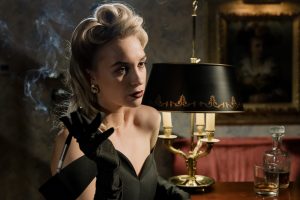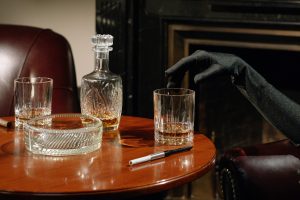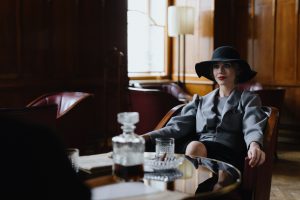Bond. James Bond. License to Kill. Shaken not stirred.
It’s a franchise that has attracted almost half of the world’s population. James Bond is a British cultural icon: one that continually reflects and adapts with the times. From Sean Connery’s blatant womanizing in the 60s, to Daniel Craig’s more vulnerable tenure as 007, James Bond continues to captivate audiences. And part of this formula is, of course, the ‘Bond Girl’: a figure who has received both rapturous praise, and scathing critique. Nonetheless, I argue these figures often eclipse far more interesting characters: that of the female villain. These women, rather than succumb to Bond’s charms, resist his attempts at wooing, and in doing so, upheave the traditional Bond formula. With this in mind, I will review my top ten female villains of the Bond franchise which, to my mind at least, certainly haven’t garnered enough attention.

‘Photo of woman smoking cigar’, by cottonbro studio on Pexels.
10) Rosa Klebb
Colonel Rosa Klebb, Soviet counter-intelligence officer for SPECTRE, is Bond’s primary antagonist in Fleming’s 1957 novel From Russia with Love, and the subsequent film adaptation of the same name (1963). She is meticulous, cunning, and most importantly, tyrannical. Most well known for her iconic shoe blade (which, actually, nearly kills Bond in the novel), Klebb is certainly one of Bond’s most deadly opponents (not to mention the most unpleasant).
9) Irma Bunt
Blofeld’s right-hand woman in George Lazenby’s one and only outing as Bond, On Her Majesty’s Secret Service (1969), Bunt was responsible for a great many things: including the death of Bond’s only wife, Tracy Bond (played by the late Diana Rigg). The heart-wrenching scene of Bunt shooting Tracy in her wedding dress never fails to shock me. Underscored with Louis Armstrong’s theme song ‘We Have All the Time in the World’, this is the first time that viewers truly get to see a defeated, vulnerable Bond. And it’s all because of Blofeld’s villainous agent, Irma Bunt.
8) Pussy Galore
Although technically a ‘Bond Girl’ by the end, Pussy Galore started out as one of Goldfinger’s loyal pilots. Despite the offensive double-entendre (something that is not lost on many viewers, including myself) Honor Blackman’s outing as Pussy Galore will always be an iconic moment in cinema. Her curt reaction to Connery (“You can turn off the charm. I’m immune”) is certainly the most memorable, distinguishing her from the other, more submissive Bond Girls before her.

‘Photo of Clear Drinking Glass on Brown Wooden Table’, by cottonbro studio on Pexels.
7) Xenia Onatopp
Famke Jassen’s Xenia Onatopp is a force to be reckoned with in Brosnan’s initial outing as Bond in Goldeneye (1995). In fact, I would even go so far as to say she eclipses the film’s primary antagonist, Alec Trevelyan, played by Sean Bean. It’s the 90s, after all, and what better way to celebrate ‘Girl Power’ than with a daring female assassin, who crushes men’s heads between her thighs? Okay, perhaps it’s not the best example at modern representation; but it cannot be denied that Xenia is one of the franchise’s most dangerous assassins.
6) Helga Brandt
You Only Live Twice (1967) gives us further insights into the mysterious organisation, SPECTRE. As part of this, we are introduced to ‘Number 11’, or rather, Helga Brandt (played by Karin Dor). A prime example of the femme fatale trope, Brandt has Bond tied to a chair, and toys with him using a scalpel. It’s a terrific scene! Sadly, however, she cannot make it any further up the list due to her premature death at the hands of Blofeld. Audiences were truly robbed.
5) May Day
What better person to play the role of a psychopath’s deadly henchwoman than the ‘pioneering queen of pop’, Grace Jones? May Day is absolutely terrifying. In fact, feminist Bond scholar Lisa Funnell notes, she’s one of the few female characters in the entire franchise to determine her own fate. After being betrayed by her lover Zorin, May Day’s sacrifice is done on her own terms, not Bond’s. Not bad for 80s representation, eh?

‘Elegant Woman sitting in an Armchair’, by cottonbro studio on Pexels.
4) Miranda Frost
Die Another Day (2002) is an objectively terrible film for many reasons, with or without the invisible car. Rosamund Pike’s Miranda Frost, however, is one of the film’s redeeming elements. Masquerading as one of Bond’s lovers, her betrayal of Bond is a fantastic plot twist, and utterly out of left field. “It really is death for breakfast”, she says to Bond, before shooting him in the head. Truly an iconic moment.
3) Elektra King
Continuing on in the ‘Bond Girl becomes villain’ plot twist, we have Elektra King in The World is Not Enough (1999). It is, perhaps, one of the biggest plot twists in all of James Bond history. Elektra King, with her seemingly innocent persona, underscored with a soothing Elektra theme song, lulls Bond and the audience into a false sense of security. But little do we realise that she is the true schemer behind it all. Strapping Bond to a chair, with a chain around his neck – Elektra King is one of the franchise’s most fearsome, not to mention most manipulative, villains.

‘People playing poker in a casino’, by Anna Shvets on Pexels.
2) Vesper Lynd
It’s hard to say whether Vesper Lynd is a villain. After all, Casino Royale (2006) is, first a foremost, a love story. Eva Green’s heart-breaking betrayal of Daniel Craig’s Bond is utterly shattering. And the worst thing is, it isn’t even her fault. And because of this, Lynd’s treachery is something which goes on to define Craig’s tenure as Bond. In fact, the remainder of the franchise is, essentially, him coming to terms with the fact that the woman he loved betrayed him. It’s deeply tragic, but so intensely moving. Not to mention, Eva Green’s performance as Vesper is, in my view, one of the greatest in the franchise.
1) Fiona Volpe
And last but certainly not least, we have Luciana Paluzzi’s enthralling femme fatale Fiona Volpe, in the 1965 film Thunderball. It’s surprising to find good examples of female representation in the 60s, admittedly. Volpe, however, is a notable case of genuine empowerment. Praised by Lisa Funnell as one of the franchise’s most iconic female antagonists, Volpe is both alluring, and terrifying. One of few characters to actively thwart Bond’s masculinity, Volpe even goes so far as to taunt his sexual performance: “What a blow it must have been, you having a failure”. She’s a fantastic villain, not to mention the most seductive.

‘Chess Piece’, by Pixabay on Pexels.
So that concludes our top ten list of female villains in the Bond franchise. They are, in my view, a grossly underestimated trope in the saga – one that deserves considerably more attention than they get. And as we slowly progress into our next era of James Bond films, I’m sure there will be a great many more to come.
Featured image: cottonbro studio on Pexels.
